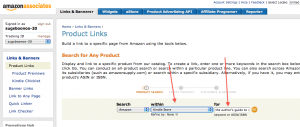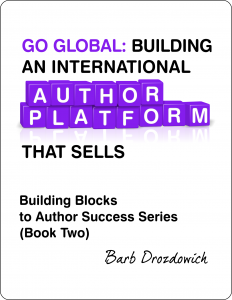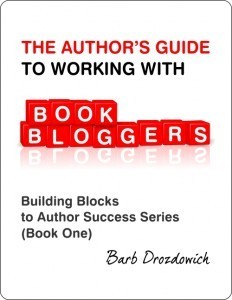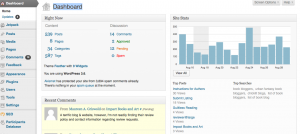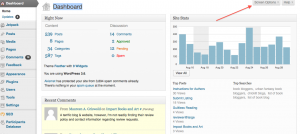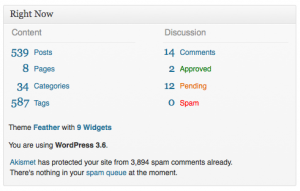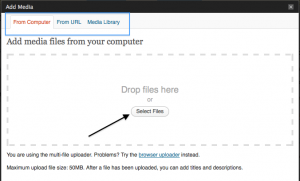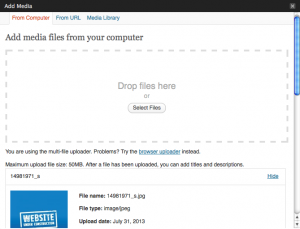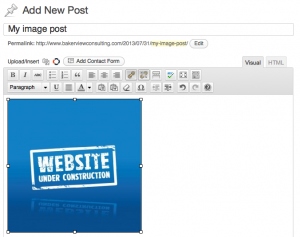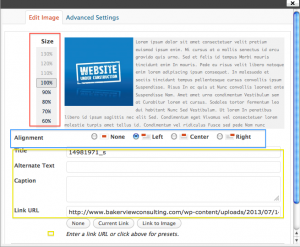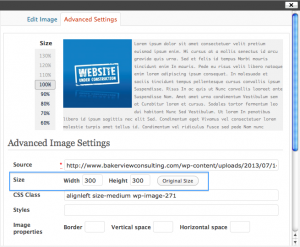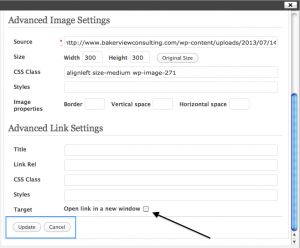Barb Drozdowich's Blog, page 50
January 27, 2014
How to add Amazon affiliate links to a post
Many people add an Amazon Affiliate link to their post. It is a way of offering your readers an easy way to purchase the product that you are talking about. Let’s face it, most of us can’t support a family with affiliate money, but my Amazon affiliate supplies me with the odd book.
I have a pet peeve about the appearance of links in posts – especially book reviews posts or book features posts. I don’t want to see a nasty long Amazon link in the post like this:
and I don’t want to see a cover graphic that is obviously an affiliate graphic like this:
I know….picky, picky, picky.
Here is how I set up my buy links on my blogs.
I log on to my Amazon affiliate account and hover over the Links & Banners menu item and choose Product Links from the dropdown list. That will bring up the screen below.
In the graphic above choose ‘Kindle Store’ in the drop-down indicated by the red arrow and type or copy and paste the name of the book in the field indicated by the second red arrow. Click on the Go button.
This will bring up choices as you can see in the graphic above. Find the book that you are looking for in the list and then click on the Orange ‘Get Link’ button.
The first screen that comes up shows the cover of the book that you are featuring. I just want the text link, so I click on ‘Text Only’ as indicated by the red arrow in the graphic above. That will bring up the screen that you see above. We will need part of the code that is in the red box as indicated above.
If you look at the graphic above, you’ll see that I have highlighted part of the code. This is the portion that you want. It looks like this:
http://www.amazon.com/gp/product/B00E...
Code=as2&tag=sugsboonoo-20
The portion of the code that I want is in quotes (but don’t include the quotes), starts with an ‘http’ and ends with my affiliate id. We are going to take that code and use it as the link to embed behind a buy link like this:
Click on the link above and see where you go. Unless I told you, are you aware that you are clicking an affilate link? Isn’t it neater?
By the way, you can do this on Blogger – exactly as I’ve done it on WordPress.
Any questions? What should we chat about next?
Author information
 Barb DrozdowichOwner at Bakerview ConsultingSocial Media and Wordpress Consultant Barb Drozdowich has taught at Colleges, trained technical personnel in the banking industry and, most recently, used her expertise to help hundreds of authors develop the social media platform needed to succeed in today’s fast evolving publishing world. She owns Bakerview Consulting and manages the popular blog, Sugarbeat’s Books. Her first book is now available on Amazon - The Author's Guide to Working with Book BloggersTwitterFacebookGoogle+LinkedIn
Barb DrozdowichOwner at Bakerview ConsultingSocial Media and Wordpress Consultant Barb Drozdowich has taught at Colleges, trained technical personnel in the banking industry and, most recently, used her expertise to help hundreds of authors develop the social media platform needed to succeed in today’s fast evolving publishing world. She owns Bakerview Consulting and manages the popular blog, Sugarbeat’s Books. Her first book is now available on Amazon - The Author's Guide to Working with Book BloggersTwitterFacebookGoogle+LinkedIn
January 22, 2014
The Author’s Guide to Working with Book Bloggers – Book Trailer
It’s here!
I’m so proud of the final results!
Have a look at the trailer for The Author’s Guide to Working with Book Bloggers
Author information
 Barb DrozdowichOwner at Bakerview ConsultingSocial Media and Wordpress Consultant Barb Drozdowich has taught at Colleges, trained technical personnel in the banking industry and, most recently, used her expertise to help hundreds of authors develop the social media platform needed to succeed in today’s fast evolving publishing world. She owns Bakerview Consulting and manages the popular blog, Sugarbeat’s Books. Her first book is now available on Amazon - The Author's Guide to Working with Book BloggersTwitterFacebookGoogle+LinkedIn
Barb DrozdowichOwner at Bakerview ConsultingSocial Media and Wordpress Consultant Barb Drozdowich has taught at Colleges, trained technical personnel in the banking industry and, most recently, used her expertise to help hundreds of authors develop the social media platform needed to succeed in today’s fast evolving publishing world. She owns Bakerview Consulting and manages the popular blog, Sugarbeat’s Books. Her first book is now available on Amazon - The Author's Guide to Working with Book BloggersTwitterFacebookGoogle+LinkedIn
November 30, 2013
Good Friday Results!
Go Global: Building An International Author Platform that Sells is now ranked #20 in Public Relations.
And The Author’s Guide to Working with Book Bloggers is ranked #47 in Public Relations! Neither book will break the bank even after all the Black Friday shopping, and both are helpful for your career!
Author information
 Barb DrozdowichOwner at Bakerview ConsultingSocial Media and Wordpress Consultant Barb Drozdowich has taught at Colleges, trained technical personnel in the banking industry and, most recently, used her expertise to help hundreds of authors develop the social media platform needed to succeed in today’s fast evolving publishing world. She owns Bakerview Consulting and manages the popular blog, Sugarbeat’s Books. Her first book is now available on Amazon - The Author's Guide to Working with Book BloggersTwitterFacebookGoogle+LinkedIn
Barb DrozdowichOwner at Bakerview ConsultingSocial Media and Wordpress Consultant Barb Drozdowich has taught at Colleges, trained technical personnel in the banking industry and, most recently, used her expertise to help hundreds of authors develop the social media platform needed to succeed in today’s fast evolving publishing world. She owns Bakerview Consulting and manages the popular blog, Sugarbeat’s Books. Her first book is now available on Amazon - The Author's Guide to Working with Book BloggersTwitterFacebookGoogle+LinkedIn
November 25, 2013
Ways to link to your Book’s Sale Page
Today we are going to talk about ways to link to your book’s sale page
As many of you know, I post to quite a few blogs each day. Getting what I call “buy links” seems to be a concern. The ability of the author to supply a link to a place where readers can purchase their book is of great importance.
Frequently I have authors sending me: 00FCJBBGG. This is one of my book’s ASIN. If I enter this set of letters and numbers into my browser window, I will get an error message. This is not a link to a buy page. It is an identifying feature of my book, but not helpful for readers trying to purchase a copy of your book.
Next most commonly, I’ll get: http://www.amazon.com/Go-Global-Build...
Amazon has got to have the longest, ugliest urls possible. Do you really want that showing on someone’s post about your book? It’s nasty.
A long url like this can be shortened using a number of services.
Bit.ly will allow the creation of an account and will shorted the above link to look like: http://amzn.to/182MFc0. Much nicer. It will also keep track of how many times this link is clicked on.
Ow.ly is the link shortener that Twitter uses and will shorten the link to look like: http://ow.ly/rajvt
My favorite is Smarturl as it will produce not only interesting looking links, but also provide stats about how many time, and where from the link is clicked on.
My book, Go Global: Building an International Platform that Sells, has a Smarturl that looks like: http://smarturl.it/AuthorPlatformAmazon. I also know that this link has been clicked on 3 times so far today from my book blog. Handy to know.
All urls need to be embedded to create clickable links
Research shows that people who read an electronic source of material (a blog, or ebook, etc) have the attention span of a gnat. We need to pander to this. All links should be embedded to create a clickable link. Don’t make people copy and paste a link into a new browser window. Just have them click on it.
To do that, highlight your text….
click on the link button on your menu bar……
Insert the nasty long url and click on the insert button…..
and your link looks like this: Buy this book at Amazon
Any questions? Don’t hesitate to ask!
Author information Barb DrozdowichOwner at Bakerview ConsultingSocial Media and Wordpress Consultant Barb Drozdowich has taught at Colleges, trained technical personnel in the banking industry and, most recently, used her expertise to help hundreds of authors develop the social media platform needed to succeed in today’s fast evolving publishing world. She owns Bakerview Consulting and manages the popular blog, Sugarbeat’s Books. Her first book is now available on Amazon - The Author's Guide to Working with Book BloggersTwitterFacebookGoogle+LinkedIn
Barb DrozdowichOwner at Bakerview ConsultingSocial Media and Wordpress Consultant Barb Drozdowich has taught at Colleges, trained technical personnel in the banking industry and, most recently, used her expertise to help hundreds of authors develop the social media platform needed to succeed in today’s fast evolving publishing world. She owns Bakerview Consulting and manages the popular blog, Sugarbeat’s Books. Her first book is now available on Amazon - The Author's Guide to Working with Book BloggersTwitterFacebookGoogle+LinkedIn
October 20, 2013
18 Ways to Get Traffic to your Blog Post
I’m not a huge fan of infographics. I find them entertaining, but often not very informative. I ran across the one below this week and loved it. I’m passing it on.
 Source: Lezal Marketing
Source: Lezal Marketing
Use the information above with some common sense thrown in. For example, the last slide, Create Outrage, this is always a dangerous prospect. One can be outrageous without starting a flame-war, but sometimes that is a difficult thing…
This graphic was created for all bloggers. I feel that it should be tailored to your specialty and your interests. If nothing else, this graphic should give you some ideas!
Have fun!
Author information
 Barb DrozdowichOwner at Bakerview ConsultingSocial Media and Wordpress Consultant Barb Drozdowich has taught at Colleges, trained technical personnel in the banking industry and, most recently, used her expertise to help hundreds of authors develop the social media platform needed to succeed in today’s fast evolving publishing world. She owns Bakerview Consulting and manages the popular blog, Sugarbeat’s Books. Her first book is now available on Amazon - The Author's Guide to Working with Book BloggersTwitterFacebookGoogle+LinkedIn
Barb DrozdowichOwner at Bakerview ConsultingSocial Media and Wordpress Consultant Barb Drozdowich has taught at Colleges, trained technical personnel in the banking industry and, most recently, used her expertise to help hundreds of authors develop the social media platform needed to succeed in today’s fast evolving publishing world. She owns Bakerview Consulting and manages the popular blog, Sugarbeat’s Books. Her first book is now available on Amazon - The Author's Guide to Working with Book BloggersTwitterFacebookGoogle+LinkedIn
September 4, 2013
Announcing the upcoming release of my next book: Go Global: Building An International Author Platform That Sells
Creating buzz for your book – and your career as an author – just got easier. Go Global: Building an International Author Platform That Sells will help you decode the mystery behind building a powerful author brand and navigating the social media platforms essential to publishing success. Social Media and Wordpress Consultant Barb Drozdowich will steer you through the technology behind international marketing without all the techno-speak. She has helped many authors just like you build an author platform that engages readers and builds sales.
Go Global teaches you why you need the various facets of the author platform to build visibility. Barb uses a simple analogy, Operation Book, to help you understand the steps to successful book marketing in the media age. She covers:
- The Difference between a Website and a Blog
- What Your Blog Should Contain
- The Important Components of a Blog
- The Nine Essential Social Media Platforms
- Newsletters
- Amazon’s Author Central
With simple-to-follow steps, Barb will help you create and manage an Author Platform to support your career.
August 29, 2013
How to customize your WordPress Dashboard
Did you know that you can change what you see when you log into your WordPress Dashboard?
Most people don’t!
Here’s what the average dashboard looks like. The menu is down the left side of the screen. The rest of the area is filled with boxes that contain information. On the screenshot above, you can see two complete boxes – on labeled Right Now and one Labeled Site Stats. I like it this way. I’ve organized it this way.
You can control which “boxes” of information show on the dashboard and you can change the placement of these boxes.
Here’s the screen shot again, but this time I’ve added a red arrow. The arrow points at a little tab called “Screen Options” Click on that tab and you will see the following:
A little screen will drop down. As you can see there are a collection of check boxes. This allows you to decide what you want to see on your dashboard. Play with the settings and see what happens when you un-check some of the items. Many of the authors that I work with have no interest in the WordPress Blog entries or “Other Wordpess News.”
Let’s look at the boxes of information that is available to you. The first one that most people see is the Right Now box. It serves as a snippet of what’s happening on your blog. It tells you how many posts, how many pages, how many tags and categories and some information about comments.
Although I like this box to be in the upper left of my dashboard. It can reside anywhere you want it. If you click on the bar at the top of the box and drag it, you can move it where ever you want it to go.
As you can see in the above graphic, I’ve moved it so that it is now in the upper right on my dashboard.
Your job now, is to log onto your WordPress blog and play with the look of your dashboard. Remove the information that you want removed, and re-order the boxes in the way that you want them viewed.
If you enjoyed this post, please signup for my tips feed and get these helpful tips delivered directly to your inbox.
I’ve published a book based on a survey of 215 book bloggers called The Author’s Guide to Working with Book Bloggers. It’s filled with little pearls of wisdom from book bloggers. Pick up a copy and learn how to access the free promotion available on book bloggers!
Author information
 Barb DrozdowichOwner at Bakerview ConsultingSocial Media and Wordpress Consultant Barb Drozdowich has taught at Colleges, trained technical personnel in the banking industry and, most recently, used her expertise to help hundreds of authors develop the social media platform needed to succeed in today’s fast evolving publishing world. She owns Bakerview Consulting and manages the popular blog, Sugarbeat’s Books. Her first book is now available on Amazon - The Author's Guide to Working with Book BloggersTwitterFacebookGoogle+LinkedIn
Barb DrozdowichOwner at Bakerview ConsultingSocial Media and Wordpress Consultant Barb Drozdowich has taught at Colleges, trained technical personnel in the banking industry and, most recently, used her expertise to help hundreds of authors develop the social media platform needed to succeed in today’s fast evolving publishing world. She owns Bakerview Consulting and manages the popular blog, Sugarbeat’s Books. Her first book is now available on Amazon - The Author's Guide to Working with Book BloggersTwitterFacebookGoogle+LinkedIn
July 31, 2013
How to put a picture in a WordPress Post
Haven’t you wondered how other people manage to put pictures in their posts exactly where they want them?
Is manipulating pesky pictures not in your bag of tricks? Let’s see if I can help you wrangle those pictures into place.
To initially place a picture in a post, click to place your cursor where you want the picture to appear. Click on the Upload/Insert words indicated by the arrow. The Add Media window will pop up (see graphic below)
As you can see the Add Media window gives you three choices of where to find the picture that you are inserting. You can find a picture on your computer’s hard drive, from a URL, or from your media library. For this exercise, we are going to assume you will be finding the picture on your hard drive. To do this, click on the Select Files button (or drop the file directly onto this window.)
Once you have chosen the graphic that you want to use and it has uploaded, your screen will look like the screenshot above. At this point you can choose the size of the picture and the orientation (left, center, right) or just click on the insert into post button.
Your picture will be inserted as you see above. Let’s say you now decide that the picture should be centered or smaller, or you need to add a caption. The picture can be edited from this point. To do this, click once on the picture and the edit button will appear over the picture (looks like a mountain picture). click on it and the following graphic will appear:
As you can see in the graphic above – The red box shows where you can change the size of the picture by percentages (ie. make it 60% of it’s current size) This change will keep the width and height in proportion as it changes. The blue box in the graphic above shows where the alignment can be changed.
Pictures should all have Titles and Alternative Text, but that is the subject for another post. The yellow box indicates where that information as well as caption can be filled in. Let’s say you want someone to be able to click on the picture and they be taken somewhere – maybe Amazon because the graphic is of your book cover. If you remove the information that is in the Link URL field and enter the Amazon direct URL, the reader can be taken to Amazon when they click on the picture.
There are more things that you can do with the picture! If you look at the top of the above graphic you’ll notice that there are two tabs – “Edit Image” and “Advanced Settings”. The “Edit Image” tab comes up first, but you can click on the Advanced settings tab see the graphic above. You’ll notice that the changing the size of the picture by percentages is still visible, but you can also change the size of the picture in number of pixels. (see the blue box) This allows you to enter numbers for the width and height – keep in mind that the proportions will not be kept doing this, and you can easily distort the picture.
As you can see in the above graphic, much of the same information is available to be changed on this part of the edit screen. The one point that I want to draw your attention to is right down at the bottom of this graphic – indicated by the black arrow. If you want your readers to click on your picture and go to a different site, make sure that that site opens in a new window. This way your reader can easily navigate back to your site when they are finished buying your book 
The last step is to click on Update (see blue box) and your picture should look exactly like you want it to look!
Good luck and have fun with pictures!
Author information
 adminSocial Media and Wordpress Consultant Barb Drozdowich has taught at Colleges, trained technical personnel in the banking industry and, most recently, used her expertise to help hundreds of authors develop the social media platform needed to succeed in today’s fast evolving publishing world. She owns Bakerview Consulting and manages the popular blog, Sugarbeat’s Books. Her first book is now available on Amazon - The Author's Guide to Working with Book BloggersTwitterFacebookGoogle+
adminSocial Media and Wordpress Consultant Barb Drozdowich has taught at Colleges, trained technical personnel in the banking industry and, most recently, used her expertise to help hundreds of authors develop the social media platform needed to succeed in today’s fast evolving publishing world. She owns Bakerview Consulting and manages the popular blog, Sugarbeat’s Books. Her first book is now available on Amazon - The Author's Guide to Working with Book BloggersTwitterFacebookGoogle+
September 9, 2012
OMG, Not My Frappucino
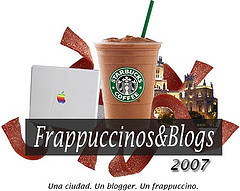
Frappuccinos & Blogs 2007 (Photo credit: Oscar J Baeza)
There you sit in your favorite chair pensively sipping on your Frappuccino, gazing out the window not noticing the people coming and going. You dream about your bestseller. Just as in years gone by, you imagine Casey Kasem announce, “and topping the charts this week is . . . your book.“ Then suddenly reality sets in: OMG, blogging, tweeting, article writing, advertising, etc., etc. All the things I need to do to expose my book to climb the charts. Sigh!
What was that you are telling yourself?
I don’t blog, I’m too old to twitter, I don’t know what to blog or tweet about, I don’t know about this SEO thing, I can’t afford to advertise, yada yada yada . . .
Let’s get real for a moment and jump out of the box. Don’t blog, don’t twitter, don’t advertise, don’t know SEO . . . as the terminator once said, “no problemo”. For little more than the cost of your Frappuccino you could:
Get a 400 – 500 word article (or blog post) written for you.
Have someone write 10 awesome tweets for you.
Have your promo message tweeted to 250,000 people 4x on twitter.
Have a Facebook Fan Page created.
Have your message posted for over 300,000 Facebook followers to see.
Submit a press release to 35+ press release sites.
Get a video made to promote your book or website.
And so much more.
Fiverr.com is it. You can find all sorts of services on Fiverr.com for a mere $5. Just a little more than the cost of Frappuccino each day, you can do book promotion. This site is nothing short of faaaaantastic! Don’t blog, don’t twitter, don’t advertise, don’t know SEO . . . “no problemo.”
Also, for a little more than the cost of your Frappuccino each day, you could do promo activities with a paid search or display network ad campaign.
Advertise your video on YouTube and get up to 500 views of your video from searches on YouTube.
Have your book seen each day thousands of times on a number of websites like FanFiction.net.
Get up to 30 clicks per day to your book page from organic searches.
Also, for little more than a couple Frappuccino’s you can get an author interview or do a guest post at @IndieBookPromos (indiebookpromo.com).
You are in a global marketplace. Whether you can or can’t do any of the above is of no consequence. It is so easy to find others who can do it for you, which will free you up to do what you want and like to do, write.
So, tomorrow as you sit in your favorite chair pensively sipping on your Frappuccino, gazing out the window and dreaming about your bestseller, that great coffee aroma swirling around you enticing the senses, the coffee slowly vanishing from your cup — remember, so too are vanishing readers.
No more excuses! You can do it all for little more than the cost of your Frappuccino. EXPOSE yourself, NOW!
Until next time…
“Keep your feet on the ground and keep reaching for the stars.” Casey Kasem
AdWords, as simple as 1-2-3. Get your ad campaign going in minutes! J.P. the AdWords Guy can help you with a task that will seem like you are in a cognitive learning experiment. If you are looking to GET EXPOSED and drive traffic to your Amazon page or book web site, the AdWords Guy can help you. Call, NOW!
949-431-3841
J.P. Thompson

Author information
 adminSocial Media and Wordpress Consultant Barb Drozdowich has taught at Colleges, trained technical personnel in the banking industry and, most recently, used her expertise to help hundreds of authors develop the social media platform needed to succeed in today’s fast evolving publishing world. She owns Bakerview Consulting and manages the popular blog, Sugarbeat’s Books. Her first book is now available on Amazon - The Author's Guide to Working with Book BloggersTwitterFacebookGoogle+
adminSocial Media and Wordpress Consultant Barb Drozdowich has taught at Colleges, trained technical personnel in the banking industry and, most recently, used her expertise to help hundreds of authors develop the social media platform needed to succeed in today’s fast evolving publishing world. She owns Bakerview Consulting and manages the popular blog, Sugarbeat’s Books. Her first book is now available on Amazon - The Author's Guide to Working with Book BloggersTwitterFacebookGoogle+
September 3, 2012
Write It And They Will Come…NOT!
 If you are thinking that a bunch of ghosts of famous writers are going to show up on your site, and droves of readers are going to flock to see them to help promote your book…that’s not going to happen. Not by any stretch of the imagination.
If you are thinking that a bunch of ghosts of famous writers are going to show up on your site, and droves of readers are going to flock to see them to help promote your book…that’s not going to happen. Not by any stretch of the imagination.
If you search on Google for let’s say “romance novels,” it will return over 38 million results. There are about 10 results showing per page . . . well, let’s just say you are a penguin in a sea of penguins.
Let’s quickly do a reality check.
Google research indicates that there are approximately 130 million published books.
Amazon has approximately 1.7 million titles listed. Type in “romance novels” at Amazon/books and it will return approximately 38K results.
2011: about 3 million books published.
2012: is estimated to hit about 12 million books published.
Alison Flood of the Guardian points out that a DIY study suggests that self-published authors make less than $500.00 .
The hard reality . . . books are easy to find; buyers are not.
If you are interested in selling your book, it’s now time to take off your author hat. You need to think like a marketer. You now need buyers…so, how do you get buyers?
First and foremost is EXPOSURE
ENGAGE your potential buyer
Offer them interesting or helpful content
GOT FANS? Sometimes we are our own worst enemy when it comes to selling. I know; I am a master sales trainer of 34 years. What I hear from authors:
I don’t blog.
I’ll never guest post.
I don’t know what to blog about.
My book is not selling; can you recommend a top agent for me in NYC?
I will advertise when book sales are better.
I am too old to use twitter.
I hate Facebook.
I don’t want people to find me.
I won’t sell a book on twitter.
“Hello, McFly!” Where do you think your buyers are going to come from?
A search on Google? You’re 1 in 38M!
A search on Amazon? You’re 1 in 38K!
Get active! It’s all about getting your book or yourself out there as an author so potential buyers see you and what you write. There is a reason approximately $80B was spent last year on business to consumer advertising. EXPOSURE!
Here are 10 things you can do right NOW to EXPOSE YOURSELF:
Create a blog
70% of the millions surveyed buy due to reading a blog.
50% of those people read a blog once daily.
Then drive traffic to your blog:
Get Reviews
Guest Blogging
Face Book Fan Page
Google +1
Pintest
GoodReads
YouTube Video
Use a book promo service
Advertise
Create a book webpage
Create a book website with a blog (e.g., humanbodydetectives.com)
Create a blog with a link to a book webpage (e.g., rachelintheoc.com)
Make the book webpage visually interesting and enticing
Be sure to have a buying page or a link to where they can buy your book on your blog and book webpage with a strong call to action.
Set up a Facebook fan page
Set up a Twitter account
You can tweet about your blog posts or book subject matter (just learn how to use the site properly so you don’t spam or self-promo exclusively).
Reviews: Get beta readers to read your book.
Visit badredhedmedia.com for more information
Minimum of 10 reviews
Minimum 25 likes
Set up a Google+1 account, LinkedIn account, GoodReads, and Pintrest account
Set up a YouTube account.
Create a video
You can have a video created for as little as $5 on Fiverr.com (e,g., $45 video example at http://youtu.be/KHRj8kfbzRI)
You can also advertise your video on YouTube for as little as $.01 per view
Use a service to promote your book
BadRedHeadMedia.com
BookBuzzr.com
IndieBookPromo.com
Advertise
Use AdWords (Google)
or AdCentral (Bing and Yahoo)
 Until next week, expose yourself!
Until next week, expose yourself!
J.P. Thompson
Also, visit my blog on selling at Salescafe
Author information
 adminSocial Media and Wordpress Consultant Barb Drozdowich has taught at Colleges, trained technical personnel in the banking industry and, most recently, used her expertise to help hundreds of authors develop the social media platform needed to succeed in today’s fast evolving publishing world. She owns Bakerview Consulting and manages the popular blog, Sugarbeat’s Books. Her first book is now available on Amazon - The Author's Guide to Working with Book BloggersTwitterFacebookGoogle+
adminSocial Media and Wordpress Consultant Barb Drozdowich has taught at Colleges, trained technical personnel in the banking industry and, most recently, used her expertise to help hundreds of authors develop the social media platform needed to succeed in today’s fast evolving publishing world. She owns Bakerview Consulting and manages the popular blog, Sugarbeat’s Books. Her first book is now available on Amazon - The Author's Guide to Working with Book BloggersTwitterFacebookGoogle+


